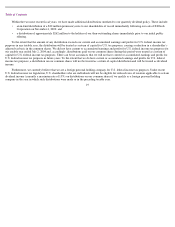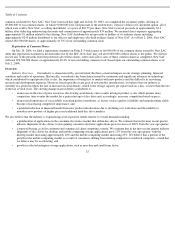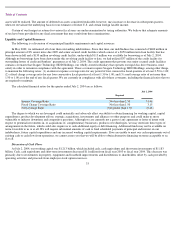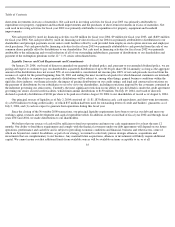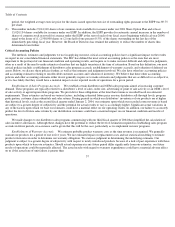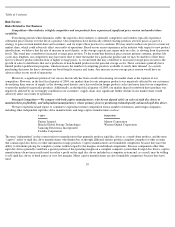Seagate 2003 Annual Report Download - page 30
Download and view the complete annual report
Please find page 30 of the 2003 Seagate annual report below. You can navigate through the pages in the report by either clicking on the pages listed below, or by using the keyword search tool below to find specific information within the annual report.
Table of Contents
1-inch form factor rigid disc drive targeted at a variety of handheld consumer electronics applications such as digital music players and digital
cameras.
We continued to maintain various sales programs aimed at increasing customer demand. We exercise judgment in formulating the
underlying estimates related to distributor inventory levels, sales program participation and customer claims submittals in determining the
provision for such programs. During fiscal year 2004, sales programs issued and recorded as contra-revenue, were approximately 7% of our
gross revenue, compared to 5% of our gross revenue for fiscal year 2003. The increase in the provision for sales programs as a percentage of
our gross revenue in fiscal year 2004 as compared to fiscal year 2003 was the result of higher distribution unit sales, particularly in the first half
of fiscal year 2004.
Cost of Revenue. Cost of revenue for fiscal year 2004 was $4.765 billion and was flat from $4.759 billion in fiscal year 2003. Gross
margin as a percentage of revenue for fiscal year 2004 was 23% as compared with 27% for fiscal year 2003. The decrease in gross margin as a
percentage of revenue was primarily due to price erosion as a result of fewer new product introductions and longer product cycles caused by a
slowing in the rate of increase in areal density. Gross margin as a percentage of revenue for the first, second, third and fourth fiscal quarters of
2004 was 27%, 26%, 22% and 17%, respectively.
Product Development Expense. Product development expense decreased by $4 million, or 1%, for fiscal year 2004 when compared
with fiscal year 2003. The decrease in product development expense from fiscal year 2003 was primarily due to decreases of $30 million in
employee incentive compensation, a $6 million business development grant received in fiscal year 2003, $4 million in legal expense and the
absence of $4 million in product development expense incurred in the year-ago period by XIOtech which we sold in fiscal year 2003. These
decreases were partially offset by increases of $21 million in salaries as a result of increased headcount and annual merit increases, $11 million
in program materials and $7 million in depreciation.
Marketing and Administrative Expense. Marketing and administrative expense decreased by $67 million, or 19%, for fiscal year 2004
when compared with fiscal year 2003. The decrease in marketing and administrative expense from fiscal year 2003 was primarily due to the
absence of $16 million in marketing and administrative expense incurred by XIOtech which we sold in fiscal year 2003, and decreases of $12
million related to the discontinuation of an annual monitoring fee paid to certain New SAC investors, $7 million in compensation expense
pursuant to executive terminations all of which occurred in fiscal year 2003, as well as $18 million in employee incentive compensation and
$12 million in outside services.
Restructuring. During fiscal year 2004, we recorded $59 million in restructuring charges. Of the $59 million, $39 million was incurred
in the quarter ended July 2, 2004 and was associated with the planned workforce reduction that we first announced in April 2004 and
implemented in June 2004. The $39 million restructuring charge was comprised of employee termination costs relating to a workforce
reduction, primarily in our U.S. and Far East operations, of approximately 2,407 employees, 1,626 of whom had been terminated as of July 2,
2004. We expect the restructuring activities related to the charge taken in our fourth fiscal quarter of 2004 to be substantially completed by
August 2004.
The remaining $20 million in restructuring charges were incurred through the nine months ended April 2, 2004 as a result of a
restructuring plan established to continue the alignment of our global workforce with existing and anticipated future market requirements,
primarily in our U.S. design centers and Far East operations. The restructuring costs were comprised of employee termination costs relating to
a reduction in our workforce of approximately 649 employees, 626 of whom had been terminated as of July 2, 2004. The restructuring
activities taken through the nine months ended April 2, 2004 were substantially complete at July 2, 2004.
Upon completion of the fiscal year 2004 restructuring activities, we estimate that annual salary expense will be reduced by approximately
$95 million. We continue to look at opportunities for further cost reductions which may result in additional restructuring activities and
restructuring charges in the future.
29


